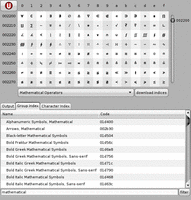Contents
unibrow
Metadata
| Description: | A unicode character browser that sits in the tray. |
| Latest Version: | 2012.12 |
| Source Code: | src/ |
| Architecture: |
|
| Dependencies: |
|
| Arch Repositories: |
|
| AUR Page: | unibrow |
| Arch Forum Thread: | 75335 |
| Tags: |
About
Unibrow is a simple unicode character browser that displays all the unicode characters systematically. It is possible to scroll through the characters with the mouse wheel or using the range slider. The characters are presented in a table with their unicode values labelled along the edges. Clicking on a character will insert it into a text buffer beneath the table. This enables basic text composition directly in unibrow, which can then be copied into another destination.
The combobox widget is populated with a list of character ranges for quick navitation, such as Greek and Cyrillic letters. The default list can be customized by editing the unibrow configuration file, which is normally located at “~/.config/unibrow/unibrow.conf” or elsewhere if specified by $XDG_CONFIG_HOME. The information dialog will display the actual path.
Unibrow can also download the Unicode Character Name Index, which the user can then search and filter to find characters.
Unibrow accepts 2 command line parameters. An integer prefixed with ‘r=’ will set the number of rows, which currently defaults to 8. An integer without a prefix will jump to the row containing the corresponding unicode character. Both integers can be specified in hexadecimal notation by prepending “0x”. For example, to display 16 rows and jump to the mathematical operators, which begin around 8704 (2200 in hexadecimal), you could enter this:
unibrow r=16 0x2200You could also have entered
unibrow r=0x10 8704to achieve the same thing. These options might be useful for creating aliases to quickly get commonly used unicode characters.
Screenshots
- Contact
- echo xyne.archlinux.org | sed 's/\./@/'
- Validation
- XHTML 1.0 Strict CSS level 3 Atom 1.0

